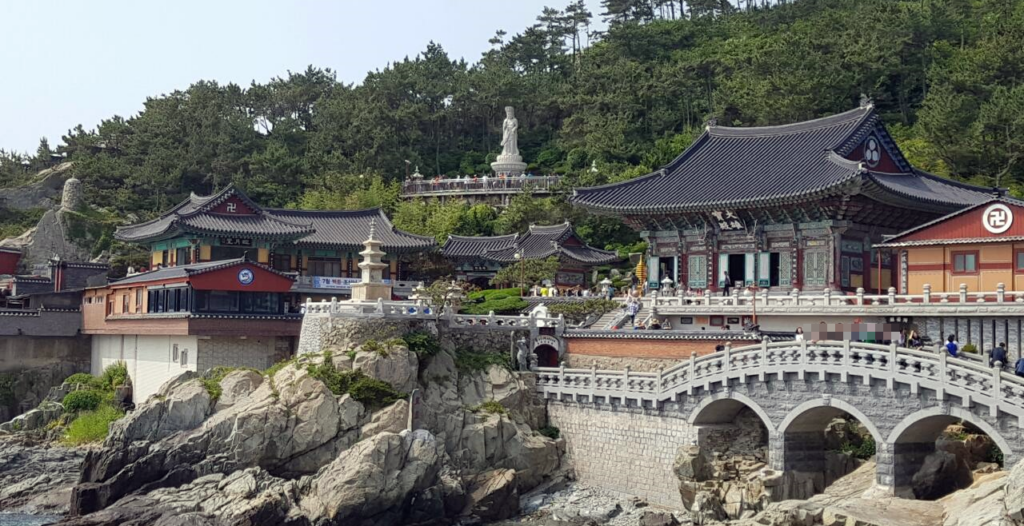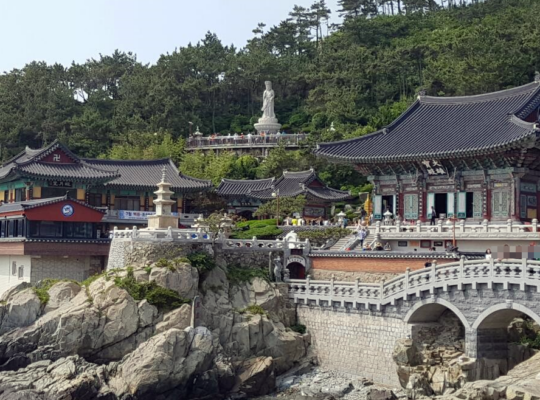Introduction
Perched on the rocky cliffs along the northeastern coast of Busan, Haedong Yonggungsa Temple offers visitors a rare opportunity to experience a Buddhist temple by the sea. Unlike most temples in Korea, which are found in mountains, this temple is an awe-inspiring destination where the Blue Dragon meets the serene waves of the East Sea. With its profound historical significance and picturesque setting, Haedong Yonggungsa is a must-visit for any traveler seeking both spiritual and scenic beauty.

A Temple With Deep Historical Roots
Haedong Yonggungsa Temple was originally built in 1376 by the respected monk Naong during the reign of King Gongmin of the Goryeo Dynasty. It is one of Korea’s three main temples dedicated to the Goddess of Mercy, Avalokitesvara (Gwaneum). The temple’s name, which translates to “Dragon Palace Temple”, reflects the local legends of dragons and the sea, symbolizing protection and blessings.
Throughout its long history, the temple faced destruction during the Japanese invasions of Korea (Imjin War) in the late 16th century. However, it was lovingly restored in the 1930s and again revitalized in the 1970s by Monk Jeongam, who had a vision of Bodhisattva Gwaneum riding a dragon during a 100-day prayer retreat. This divine encounter led to the temple’s renaming as Haedong Yonggungsa.
Spirituality Amidst Coastal Beauty
What sets Haedong Yonggungsa apart from other temples is its stunning seaside location. Visitors can witness the fusion of spiritual devotion with the raw beauty of nature. The temple complex offers a unique experience as you hear the sound of crashing waves while exploring various prayer halls and statues.
As you approach the temple, you’ll first encounter the 108 steps symbolizing the 108 earthly desires in Buddhism. These steps lead visitors down to the temple, offering magnificent views of the East Sea. Along the way, you’ll pass the Dalma Statue, believed to grant blessings to those who touch its nose and belly, particularly for those praying for children.
Architectural Marvels and Sacred Sites
The main hall of the temple, the Daeungjeon, is dedicated to the Buddha of Enlightenment and is a place where visitors can offer prayers. Nearby, you’ll find the Cave Shrine (Gulbeopdang), where a sacred Maitreya Buddha statue is enshrined. This statue is commonly referred to as the “child-giving Buddha” because many locals believe that praying here can bring fertility and the blessing of children.
Another remarkable structure at the temple is the Haesu Gwaneum Daebul, a towering 10-meter-high statue of the Seawater Bodhisattva that watches over the ocean. This striking figure symbolizes the protection of those who sail or fish at sea and is a frequent subject of photographs due to its impressive size and coastal backdrop.
The temple also features a three-story pagoda, known as the Four Lion Pagoda, which represents the four basic human emotions: joy, anger, sorrow, and pleasure. This pagoda sits at the site where a large rock once stood before being destroyed during the Korean War.
A Place for Wishes and Blessings
One of the most enchanting aspects of Haedong Yonggungsa is its reputation for granting wishes. Legend has it that those who pray sincerely at the temple will have their wishes fulfilled. This belief, combined with the temple’s serene and powerful energy, makes it a popular destination for both locals and tourists seeking personal blessings.
At the entrance of the temple, you’ll also find the Traffic Safety Prayer Pagoda, which is dedicated to travelers’ protection. The 108 steps leading to the temple symbolize the spiritual journey toward enlightenment, and each step is an opportunity to reflect on one’s life and wishes.
How to Get to Haedong Yonggungsa
Haedong Yonggungsa is easily accessible by public transportation from Busan. Visitors can take the subway to Haeundae Station and then transfer to a bus that will take them directly to the temple. The scenic journey along the coast is part of the experience, as it offers a view of Busan’s dynamic seaside environment.
For those interested in exploring further, nearby attractions such as Songjeong Beach and Haeundae Beach provide opportunities to relax by the sea after your temple visit.
Why Visit Haedong Yonggungsa?
Haedong Yonggungsa is more than just a temple—it’s a place where the beauty of the natural world meets deep spiritual traditions. The temple’s cliffside location, along with its rich history and cultural significance, make it one of the most unique destinations in Korea. Whether you’re a history enthusiast, a spiritual seeker, or simply looking for breathtaking views, Haedong Yonggungsa promises an unforgettable experience.
Conclusion
As you plan your trip to Busan, be sure to include Haedong Yonggungsa on your itinerary. Its one-of-a-kind location and spiritual ambiance make it a standout destination among Korea’s many temples. Whether you’re praying for blessings, exploring the beautiful coastal paths, or simply marveling at the temple’s architecture, a visit to Haedong Yonggungsa will leave you feeling inspired and rejuvenated.







